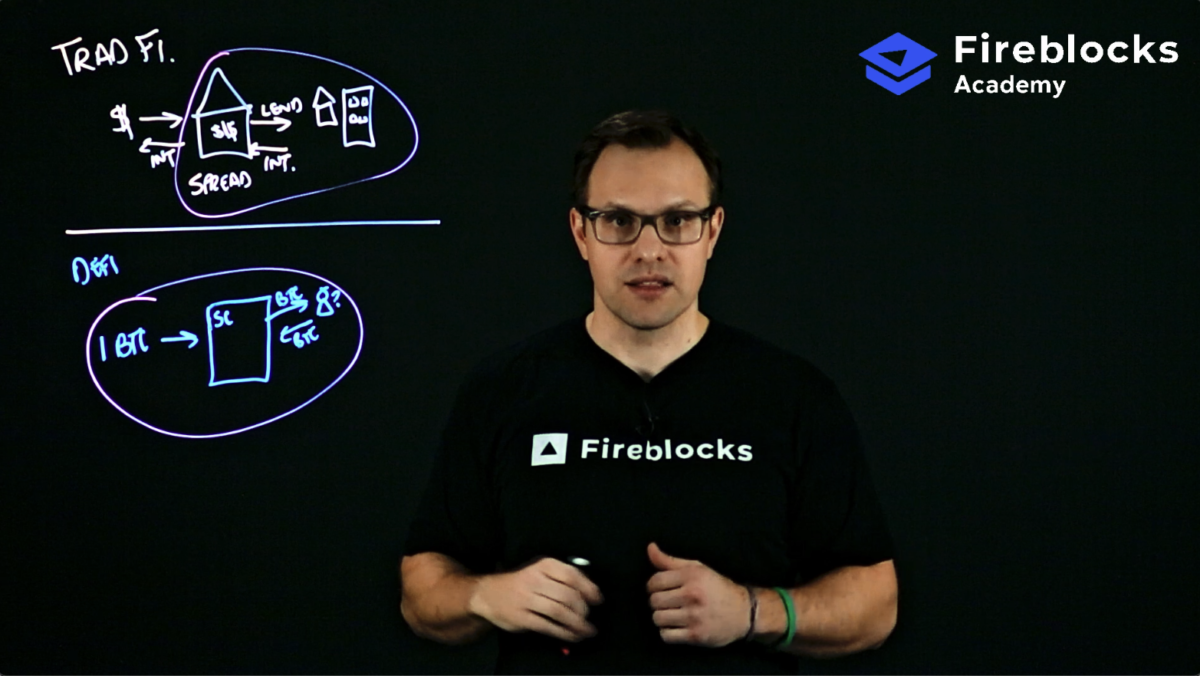Institutional DeFi
An introduction to Decentralized Finance (DeFi)
What is Institutional DeFi?
Decentralized finance (DeFi) – essentially, peer-to-peer interest-earning, borrowing, lending, and asset trading via public blockchains – has surged in the last two years, as near-zero interest rates and rising inflation have encouraged people to look for higher-yielding investment opportunities. While the essence of DeFi is to route around traditional intermediaries, financial institutions are looking to participate in DeFi’s growth.
The DeFi market expanded throughout 2020, but its growth rate skyrocketed in 2021. For example, the total value of Ethereum assets deposited and earning DeFi rewards – known as “Total Value Locked,” or TVL – rose from $15 billion at the end of 2020 to $102 billion in late October 2021. That’s still only about 5% of the total crypto marketplace. Some analysts believe DeFi will become an $800 billion industry in 2022.
Thus far, DeFi applications have primarily attracted individual, or retail, investors and crypto specialists. However, financial institutions are increasingly looking to enter the space, and there’s a range of infrastructure solutions to help them do so. . For those institutions planning to dip their toes into DeFi, here’s how the landscape looks now, what’s changing, and the developments they can expect to see soon.
The Retail DeFi Landscape
DeFi is revolutionizing finance by enabling individuals to transact directly, without the need for trusted intermediaries, so it’s unsurprising that it’s gained popularity in the retail banking and investing space.
Instead of relying on banks, brokers, and fund managers to manage their money, DeFi enables people to manage assets themselves using a range of decentralized applications (DAPPs) accessible from their smartphones. Individuals hold their own wallets, secured by private keys, but all transactions are public and recorded on permissionless blockchains such as Ethereum and Solana.
Smart contracts automatically execute transactions without the need for centralized clearing and settlement. And it’s now becoming possible to transact across multiple blockchains using DeFi interoperability protocols such as Polkadot.
As retail DeFi has grown in value, it has also become more complex. A vital ecosystem of decentralized exchanges (DEXs) and automated market makers (AMMs) is creating a highly liquid market that supports a growing range of traditional financial products – including derivatives, index trackers, and insurance – under a decentralized model. That liquidity also supports innovative high-yield products such as governance tokens (which are considered valuable because they grant voting rights over changes to DeFi protocols) and yield farming (aka “liquidity mining,” in which market participants earn fees for providing liquidity to a DEX).
Apart from providing liquidity to exchanges, people can use DeFi to earn income by trading fiat currencies, crypto, and stablecoins; lending or “staking” crypto and stablecoins; pooling funds in an insurance protocol; and tracking synthetic assets and indexes. Many of these products are attractive not just to retail investors but also to institutions.
Yet strategies that work for individuals who are investing their own money aren’t necessarily suitable for firms investing other people’s funds. For example, the fact that wallets and their keys are personal can create problems for institutions that have authorization procedures designed to prevent major investment decisions from being made by single individuals. And when DEXs and DAPPs are accessed via browsers, keys can become visible to hackers. Because of these security risks, institutions using retail apps to access DeFi could find it difficult to obtain insurance for their assets.
Furthermore, the fact that wallets are personal and private can make it very difficult for regulated financial institutions to comply with know-your-customer/anti-money laundering (KYC/AML) rules or even maintain an audit trail. The absence of centralized institutions deciding who can and can’t transact is among DeFi’s principal attractions in the retail world since it enables the “unbanked” to participate in the world of digital finance, but it does create certain regulatory and compliance concerns.
Some institutions are opting to develop bespoke, secure DeFi access. But DeFi is a fast-growing market, and: keeping up with the pace of development creates considerable software engineering overhead.
How Institutional Investors Participate in DeFi
The DeFi ecosystem is highly attractive for institutional investors searching for returns in a yield-starved world. As a result, institutional DeFi is growing fast.
Institutions can trade on decentralized exchanges such as Uniswap and Curve, lend and borrow using decentralized protocols such as Compound and Aave, or take part in innovative yield farming protocols such as Yearn. Lending protocols typically deliver higher yields on deposits than are available in traditional finance, while yield farming is an innovative development that can deliver very high yields for investors with significant assets.
DeFi lending protocols issue tokens as “receipts” for cryptocurrency and stablecoin deposits, which can themselves be traded or staked. For example, investors who deposit USD Coin – a stablecoin fully backed by cash and equivalents – in Compound receive tokens called cUSDC. They earn passive income on their deposit and can additionally deposit the cUSDC in another lending pool, stake the cUSDC in a yield farming protocol, or use it as collateral against borrowing. The DeFi practice of “tokenizing” deposits and issuing tokens in return for liquidity enables investors to quickly build high-yield portfolios.
Institutional investors can also invest in financial products similar to those found in traditional finance, but reimagined for DeFi. For example, Synthetix offers derivatives, synthetics, and index trackers, while several protocols provide opportunities for investors to earn income by participating in insurance pools.
Many small and lightly regulated institutions are able to use retail DeFi apps and protocols. However, larger institutions and those subject to financial regulation need greater security and control, and even smaller firms may find retail apps problematic, as they are not designed to handle institutional volumes.
Features that are specifically designed to meet the needs of institutions are now becoming more widely available. These include custody of keys, multi-sig key security, algorithmic trading automation, and internal procedures support. Secure access points enable institutions to plug into a range of DeFi protocols without compromising security. And the natural transparency and auditability of blockchains and smart contracts are enhanced by a range of audit and governance tools.
But for some institutions, improved security and auditability may not be enough. For example, institutions subject to KYC/AML regulations can’t trade with anonymous counterparties. To address these challenges, “permissioned” protocols such as Aave Arc, which creates lending pools consisting only of KYC’d counterparties, could enable regulated institutions to participate in DeFi. These solutions could also be attractive to other institutions if rates are better than those found in “permissionless” DeFi.
Institutional DeFi with Fireblocks
For financial services organizations pursuing DeFi strategies, Fireblocks offers secure, enterprise-grade, and easy-to-use access to decentralized exchanges and apps.
With Fireblocks’ DeFi API and browser extension, institutions can launch DeFi strategies without compromising security, operational, or regulatory requirements. Fireblocks is now fully integrated into WalletConnect, which provides more secure access to DAPPs. Investors can access DeFi protocols and manage DeFi wallets directly through the secure Fireblocks platform, with no need to download apps or wallets, or to self-custody keys offline.
Fireblocks uses MPC (Multi-Party Computation), SGX hardware defense, and multi-user authentication workflows to secure assets in custody and during transfer.
Investors can configure the platform to conform to internal procedures, such as restricting access to less established protocols and setting limits by asset or role within the organization. Automated transaction logs and AML/KYC enable investors to meet compliance and auditability requirements. And with up to $30 million insurance against hardware and software faults, institutions can use the platform with confidence and peace of mind.
DeFi offers major opportunities for institutional investors, and Fireblocks empowers financial institutions to participate fully in this exciting, fast-growing space with the security, efficiency, and flexibility they need to be competitive in the market.



